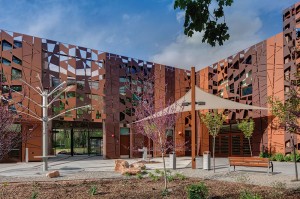Dunn Associates, Inc. was an Outstanding Award Winner for the Tracy Aviary Visitors Center project in the 2013 NCSEA Annual Excellence in Structural Engineering awards program (Category – New Buildings under $10M).
The Tracy Aviary, located at Liberty Park, initiated a massive renovation that will completely transform its physical landscape and exhibits to renew its position as one of Salt Lake City’s prized assets. To begin this renovation, the Aviary needed a new multifunction facility. The building needed to house a visitor center, gift shop, ticketing and entrance facilities, staff offices and open classroom/learning spaces. This building would truly be a focal point for families and patrons as they entered the grounds.
On the site, the Visitor’s Center and associated boardwalk frame a nearby pelican pond. The soils are a combination of saturated loose sands and clays. These challenging soil conditions lead to a dual solution for the building and boardwalk. The building, at its closest only 5 feet away from the pond, was founded on a mat footing. Due to tight budget constraints, the thickness was varied around the perimeter. This allowed the higher loads at the masonry bearing walls and steel moment frames to be adequately resolved. As traditional spot footings would be too invasive to install in and near the pond, the surrounding boardwalk was supported by helical piers.
The Visitors Center’s plan is a gentle ‘Z’ form, weaving the building and visitor circulation through art, trees, and the Pelican Pond. Connecting the two ‘L’ shaped wings that are arranged to form this ‘Z’ shape is a bridge, which covers the ticketing and visitor entrance to the Aviary. The bridge is rigidly connected to one wing and incorporates an expansion joint. This joint allows for both seismic induced lateral displacement and thermal expansion.
Interior spaces needed to be as open as possible to allow easy patron flow and possible future reconfiguration. To keep the floor plan open, the roof and floor framing spans from exterior to exterior. Composite wide flange beams form the floor framing. The roof is steel open web joists.
Early in the design process, the building exterior was completely concrete masonry units, for both gravity bearing and lateral load resistance. As the owner’s vision for the aesthetics of the building evolved, so did the exterior walls. In order to increase visitor’s and staff’s views, and increase the inviting nature of the building, more and more windows were added. Eventually enough windows were added that steel moment frames needed to be introduced. The varying lateral stiffness of each of these systems presented challenges in detailing. Correct expansion joints and slip conditions were required to make sure each of these lateral systems, as well as other architectural and mechanical systems, could accommodate the lateral drift.
One of the buildings most notable features is the custom metal façade that forms the skin. This was accomplished by using sheets of thin steel plates. The connections of plates to the building had to respect the variable nature of the building’s dual lateral system in addition to supporting their own gravity loads. A light, airy exterior was architecturally desired and incorporated an abstract pattern that suggests a tree canopy and branches, while evoking a sense of motion. The metal panel system was held out, away from the exterior.
Green Building strategies include reduced energy consumption provided by a photovoltaic solar array on the roof, energy-efficient building systems which are 36% more efficient than a “baseline” building, extensive use of locally sourced and recycled materials, use of low-emitting products such as paint, adhesives, and flooring. In addition, 75% of construction waste was recycled.▪

